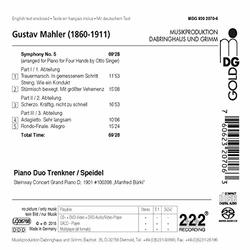| All Artists: Evelinde Trenkner, Sontraud Speidel Title: Mahler: Symphony No. 5 (arr. for piano for 4 hands) Members Wishing: 0 Total Copies: 0 Label: MDG GOLD Release Date: 3/1/2019 Album Type: Hybrid SACD - DSD Genre: Classical Styles: Forms & Genres, Concertos, Symphonies Number of Discs: 1 SwapaCD Credits: 1 UPC: 760623207063 |
Search - Evelinde Trenkner, Sontraud Speidel :: Mahler: Symphony No. 5 (arr. for piano for 4 hands)
 | Evelinde Trenkner, Sontraud Speidel Mahler: Symphony No. 5 (arr. for piano for 4 hands) Genre: Classical A beginning could not be lonelier and more desolate: only a single trumpet opens the Funeral March at the beginning of Gustav Mahlers Symphony No. 5. What is gripping already in the orchestral version is shockingly exposed... more » |
Larger Image |
CD Details
Synopsis
Product Description
A beginning could not be lonelier and more desolate: only a single trumpet opens the Funeral March at the beginning of Gustav Mahlers Symphony No. 5. What is gripping already in the orchestral version is shockingly exposed in Otto Singers arrangement for piano four hands. With this recording premiere the Evelinde Trenkner-Sontraud Speidel Piano Duo reaches a new high point in its long discography, this time with a performance that is very moving emotionally. Along with the breathtaking beginning, the famous Adagietto not least plays its role here. As the film music in Viscontis Death in Venice, this movement became a box-office hit. The piano version requires the most delicate touch and meticulous use of the pedal- music as if made to order for the Trenkner-Speidel Duo, which here has very advantageously applied its decades of experience with the transcription of symphonic scores. And then there is the fascinating clarity that Mahlers symphony attains in the piano arrangement. Daring polyphonic structures suddenly come vividly into view, especially in the intricate rondo finale. And the interlocking in the opening cortege clearly assumes a more distinctive profile. Gustav Mahler authorized Singers piano version- but not before he had intervened to offer his own advice. Once again the Trenkner-Speidel Piano Duo shows that a reduction for the piano does not necessarily mean limitations. The new perspectives on what is perhaps an exceedingly familiar work offer surprising insights and compensate for many a wind solo. The mighty Manfred Burki Steinway D from the period of the symphonys composition is captured in three dimensions on this recording and presented with painstaking precision on a Super Audio album- and the result is an authentic fin-de-siecle atmosphere.
